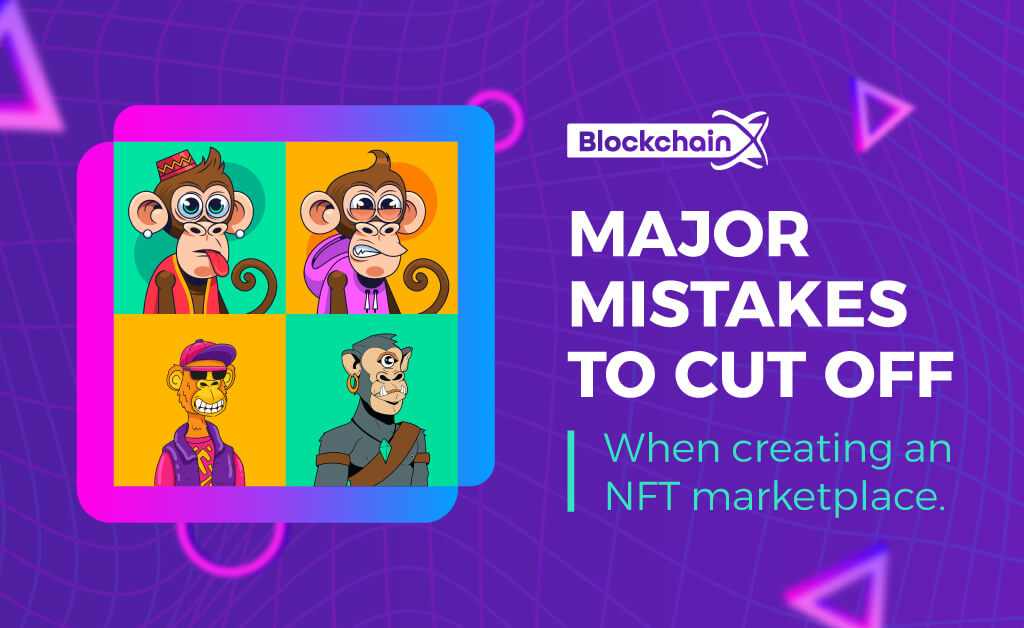
6 Mistakes You Should Avoid When Developing an NFT Marketplace
The NFT marketplace has gained popularity in recent times due to the proliferation of NFTs. NFT marketplace is a virtual place where you can trade, buy or sell digital tokens.
Building an NFT marketplace is an interesting and challenging task. However, this marketplace offers a lot of opportunities from developer to buyer and seller.
If you are planning to create your NFT marketplace, then you should be aware of and avoid some of the mistakes that everyone makes. Here we point out a few of them, read this blog to learn more.
What is NFT Marketplace?
NFT Marketplace is a blockchain-based online platform for buying and selling Non-Fungible Tokens (NFTs). Anyone can buy or sell any digital assets or NFT tokens here using NFT cryptocurrency. This market is used to produce NFT tokens or any other digital assets and also to store, display and show trading. The main difference between this NFT marketplace and the traditional market is that it is a digital market where you can trade digital assets.
If you are wondering why there is a need for an NFT marketplace, here is the answer. NFTs are digital tokens that hold ownership and authenticity over an art, game, audio, video, or any other artistic output. In the NFT market, these tokens or digital assets can be bought or sold.
We hope you get what an NFT Marketplace is all about. Without further ado, let's get to our point.
Working steps of the NFT marketplace
1. Signing Up
All you need to start your work in the NFT marketplace is a crypto account. First, create your account and then link it to a supported digital wallet. These are the initial steps you need to take and enter your wallet password to complete the process using your wallet.
2. NFT Buying
NFT buying is not a big deal. You can buy the NFTs through auctions or upfront for a fixed cost. In some cases, you can try to bargain for a lower price. All you need is a good understanding of the types of NFTs to buy and their value in the market.
3. Selling NFT
Selling NFTs is more challenging than buying them, especially if it is created by a user. You can sell your NFTs through an NFT marketplace where you enter a preset price. Or you can sell it through NFT auctions. The platform will then verify the asset. Once approved, the item will be put up for sale.
4. Creating an NFT
The best platform for developing such valuable assets is Ethereum. If you are going to create your NFT, you might want to start there. First, what you require is an ERC-721-compatible Ethereum wallet. Under that, you have Metamast, Trust Wallet, and Coinbase Wallet.
After these steps, you can access and use certain platforms. Then you can start minting your NFts.
What should you avoid while building an NFT marketplace?
Not following proper NFT guidelines
Nowadays, the most famous and widely used NFT standard is ERC-721. So if you're planning to build an NFT marketplace, make sure it follows the ERC-721 guidelines. An NFT must follow the structure and naming scheme specified by the ERC-721 standard when generating data or metadata. By doing this, you ensure that NFTs generated in your marketplace are accessible to other marketplaces.
1. Receive data from an unstable database
Storing your data in a digital ledger is much safer than storing it in a database. Anyone working on the backend of the system can change the data if you are storing the marketplace information in a database which can be modified. On the other hand, the data of a digital ledger is immutable. As a result, it provides complete transparency and cannot be altered or erased.
2. Backend Writing Operation using private keys
In NFT marketplaces, transactions can be initiated from the front end or the back end. To be highly focused, during the frontend process, users sign transactions using their private key stored in their crypto wallet. What is likely to happen here is that the platform developers working on the backend use user private keys to run the backend process.
3. Inaccurate smart contract architecture
It's well-defined that a smart contract in the NFT marketplace accomplishes all the operational functions. If any action has to be done is based on smart contracts. These smart contracts trigger each action. For this reason, they are critical to how NFT marketplaces operate. It is mandatory to take care of and be focused while developing a smart contract.
4. Not implementing proper NFT fee
Every marketplace has its type of commission, whereas in the case of an NFT marketplace you have two choices royalty fee and the marketplace commission. When creating an NFT marketplace, these two commissions will help you and the artist earn more money.
5. Using third-party APIs
It's much better & safer to hold your important information regarding your NFTs in third-party APIs. All knowledge about NFT collections, transactions, users, etc is encapsulated in an NFT API. So you can retrieve an NFT's price, metadata, ownership information, exchange information, and more via APIs.





